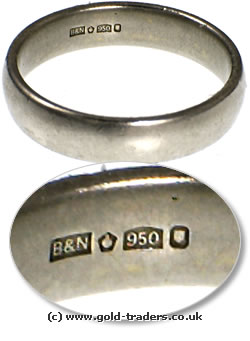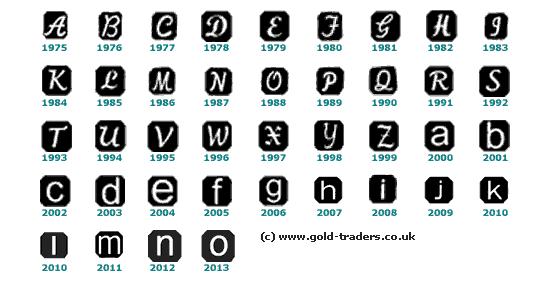Platinum hallmarking was introduced in the UK in 1975 as a result of legislation brought about by the Hallmarking Act of 1973. Prior to this date, items containing platinum would often carry no markings or simply ‘Plat’ or ‘Platinum’ and would be of varying purity.

A typical platinum hallmark
All platinum items weighing more than 0.5 grams must now carry a valid hallmark when sold in the UK. The photo on the right shows a typical hallmark. A platinum hallmark will consist of 3 compulsory and 3 optional stamps.
This post is a simple platinum hallmark guide, which we hope you find useful. If you have platinum to sell, please see our up-to-date scrap platinum prices. We also publish our scrap gold prices and our scrap silver prices.
The three compulsory platinum marks
Sponsor Mark
Also referred to as the makers mark, the first stamp in the photo indicates who submitted the item for hallmarking. Each sponsor (maker) has their own unique stamp.
Fineness Mark
The third stamp in our example photo is the fineness mark. This tells you the precious metal content, expressed in parts per thousand. There are four recognised standards of platinum:
- 850 (85% pure)
- 900 (90% pure)
- 950 (95% pure)
- 999 (99.9% pure)
When identifying an item as being platinum, it’s important to check the shape and contents of the fineness mark. If the shape is anything other than what is shown below, it isn’t platinum. As you can see, our ring is 950 platinum.

Platinum fineness
Assay Office Mark
The assay office mark tells you which assay office tested and hallmarked your item. There are now four assay offices in the UK:

Assay offices
Optional platinum hallmarks
The following 3 marks are all optional. Under hallmarking legislation, there is no compulsorary requirement to show these additional marks, however they are often shown.
Traditional Fineness Symbol
If your platinum item has a purity of 950 or 999, it may display the traditional orb mark. In our example photograph, you can see the second stamp is the traditional fineness symbol.

Orb
Date Letter
Date letters are optional and therefore not always seen (as in our example photograph). The date letter tells us the year the item was hallmarked. As date letters were standardised across all assay offices from 1975, it’s quite easy to read. Below is a chart of all date letters from 1975 onwards.

Standardised UK hallmark date letters from 1975 onwards
International Convention Mark
An International Convention Mark is sometimes shown within the hallmark. It is a mark recognised by all member countries of the International Hallmarking Convention.

Convention mark
Testing platinum
Without a valid hallmark, most jewellers and small scale gold buyers will not be able to accurately test the purity of platinum jewellery. Due to its inherent inertness, traditional ‘acid’ testing can only help determine if an item isn’t platinum, however you can’t for example differentiate 900 and 999 platinum.
High-end and specialist precious metal dealers use XRF (X-ray fluorescence) testing to accurately identify the platinum content of jewellery. Inductively coupled plasma, optical emission spectrometry is used by assay offices during the hallmarking process.

